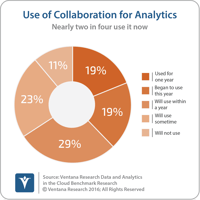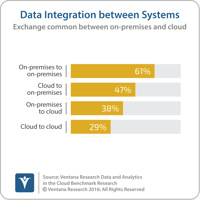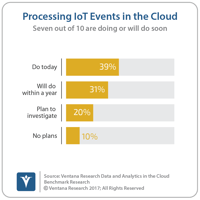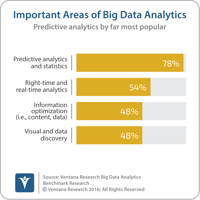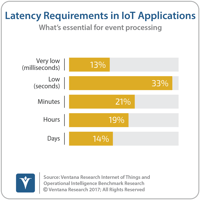In 2017 Strata + Hadoop World was changed to the Strata Data Conference. As I pointed out in my coverage of last year’s event, the focus was largely on machine learning and artificial intelligence (AI). That theme continued this year, but my impression of the event was of a community looking to get value out of data regardless of the technology being used to manage that data. The change was subtle: The location was the same; the exhibitors were largely the same; attendance was similar this year...
Read More
Topics:
Big Data,
Data Science,
Machine Learning,
Analytics,
Business Intelligence,
Data Governance,
Data Integration,
Data Preparation,
Information Optimization,
Digital Technology,
Machine Learning and Cognitive Computing
All too often, software vendors view analytics as the end rather than the beginning of a process. I’m reminded of some of the advanced math classes I’ve taken in which the teaching process focused on a few key aspects of a mathematical proof or solution, leaving the rest of the exercise to be worked out by the students. In other contexts, you may hear people say the numbers speak for themselves.
Read More
Topics:
Data Science,
Machine Learning,
business intelligence,
Analytics,
Collaboration,
Data Governance,
Information Optimization,
Digital Technology,
collaboration for business
We now are well beyond the year depicted in 2001: A Space Odyssey, a cinematic perspective on the future of artificial intelligence in which HAL 9000, a computer, is able to simulate human behavior and control machines. Anyone reviewing the past two years of marketing around AI in the business technology industry can be forgiven for believing that we have arrived at the futuristic state Stanley Kubrick imagined. We have not.
Read More
Topics:
Big Data,
Data Science,
Mobile,
Customer Analytics,
Customer Engagement,
Customer Experience,
Machine Learning,
Mobile Technology,
Analytics,
Business Intelligence,
Cloud Computing,
Collaboration,
Customer Service,
Data Governance,
Data Integration,
Data Preparation,
Internet of Things,
Contact Center,
Information Optimization,
Digital Technology,
Machine Learning and Cognitive Computing,
Cybersecurity,
Billing and Recurring Revenue,
Workforce Optimization,
collaboration for business
Advancing the potential of any business requires continuous improvement in the processes and technology that support it. Many companies have embraced attempts at a digital transformation, and it’s become a goal to which organizational resources and budgets have been dedicated around the globe.
Read More
Topics:
Big Data,
Data Science,
Mobile,
Sales,
Customer Analytics,
Customer Engagement,
Customer Experience,
Human Capital Management,
Machine Learning,
Marketing,
Marketing Performance Management,
Mobile Technology,
Office of Finance,
Wearable Computing,
Analytics,
Business Intelligence,
Cloud Computing,
Collaboration,
Customer Service,
Data Governance,
Data Integration,
Data Preparation,
Internet of Things,
Contact Center,
Information Optimization,
Product Information Management,
Digital Technology,
Digital Marketing,
Digital Commerce,
Operations & Supply Chain,
Machine Learning and Cognitive Computing,
Pricing and Promotion Management,
Cybersecurity,
Billing and Recurring Revenue,
Workforce Optimization,
collaboration for business,
mobile marketing
If we look at the focus of technology vendors for analytics and business intelligence or business applications providers deploying these capabilities in the last five years, we see that they have elevated the importance on the value of visualization and dashboards. These promotions might be understandable, but will they make business and the people using them more intelligent?
Read More
Topics:
Big Data,
Data Science,
Mobile,
Machine Learning,
Analytics,
Business Intelligence,
Cloud Computing,
Collaboration,
Information Optimization,
Digital Technology,
Machine Learning and Cognitive Computing
Informatica reintroduced itself to the world at its recent customer conference, Informatica World, in San Francisco. The company took advantage of the event to showcase its new branding in an effort to change the way customers think about the company. Informatica has been providing information services in the cloud for more than a decade. Even though cloud revenue comprises a minority of Informatica’s business, in absolute terms, the revenue is significant, and company executives want the...
Read More
Topics:
Big Data,
Data Science,
Analytics,
Business Intelligence,
Cloud Computing,
Data Governance,
Data Integration,
Data Preparation,
Information Optimization,
Machine Learning and Cognitive Computing,
Machine Learning Digital Technology
I recently attended SAS Institute’s analyst relations conference. There the company provided updates on its financial performance and its Viya platform and a glimpse into some of its future plans.
Read More
Topics:
Big Data,
Data Science,
Mobile Technology,
business intelligence,
Analytics,
Cloud Computing,
Collaboration,
Data Governance,
Data Integration,
Data Preparation,
Internet of Things,
Information Optimization,
Machine Learning and Cognitive Computing,
Machine Learning Digital Technology
Cloudera provides database and enabling technology for the big data market and overall for data and information management. As my colleague David Menninger has written, the big data and information management technology markets are changing rapidly and require vendors to adapt to them. Cloudera has grown significantly over the last decade and now has approximately 1,000 customers and provides support and services in countries around the world. Its product and technology strategy is to provide a...
Read More
Topics:
Big Data,
Data Science,
Machine Learning,
business intelligence,
Analytics,
Cloud Computing,
Data Governance,
Data Integration,
Data Preparation,
Internet of Things,
Cognitive Computing,
Information Optimization,
Digital Technology
Big data initially was characterized in terms of “the three V’s,” volume, velocity and variety. Nearly five years ago I wrote about the three V’s as a way to explain why new and different technologies were needed to deal with big data. Since then the industry has tackled many of the technical challenges associated with the three V’s. In 2017 I propose that we focus instead on a different letter, which includes these A’s: analytics, awareness, anticipation and action. I’ll explain why each is...
Read More
Topics:
Data Science,
Machine Learning,
Analytics,
Business Intelligence,
Collaboration,
Data Preparation,
Internet of Things,
Information Optimization
The big data market continues to evolve, as I have written previously. Vendors are attempting to differentiate their offerings as they seek to encourage customers to pay for technology that they could potentially download for free.
Read More
Topics:
Big Data,
Analytics,
Business Intelligence,
Internet of Things,
Information Optimization

